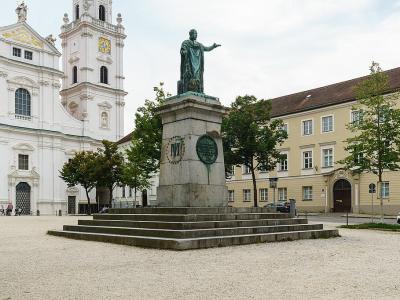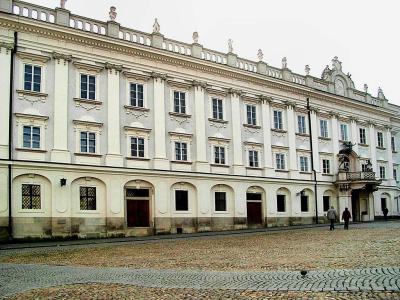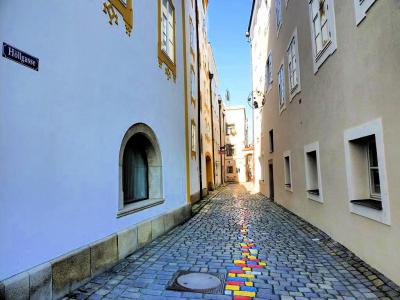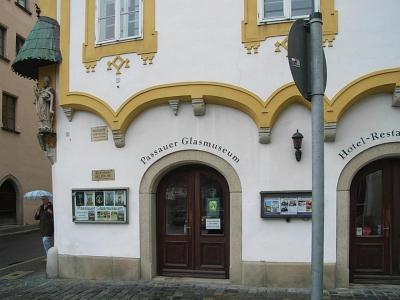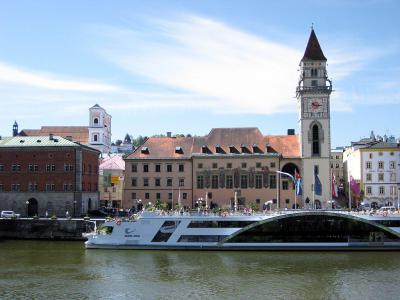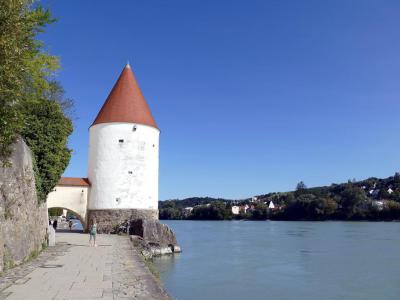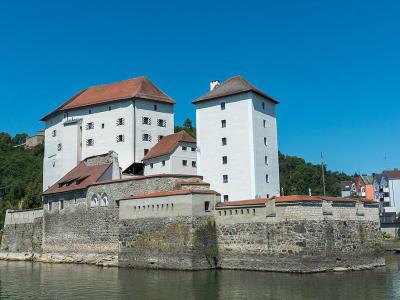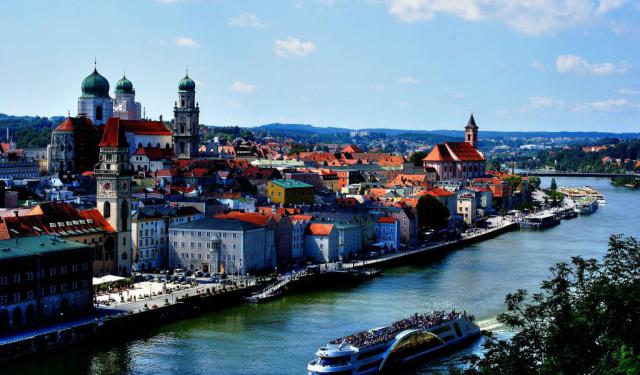
Passau Introduction Walking Tour (Self Guided), Passau
A charming German town nestled among the rolling hills of Lower Bavaria “between heaven and three rivers,” Passau is a city of natural beauty and religious pilgrimage.
Founded over 2,000 years ago, this is one of the oldest cities in Bavaria. Its history dates back to Roman times when it was a small colony known as "Batavis." The latter word translates from Latin as "for the Batavi" and refers to the ancient Germanic tribe that once inhabited the area. Over time, the name evolved into its current form, "Passau".
Dubbed the "City of Three Rivers" (Dreiflüssestadt), the town's strategic location at the confluence of the Danube, the Inn, and the Ilz rivers made it an important trading post and military base. It also brought great wealth, which together with its scenic landscapes and northern Italian-style buildings, earned Passau another nickname – the "Venice of Bavaria."
In 1662, a devastating fire consumed most of the city. Passau was subsequently rebuilt in the Baroque style. An opulent testament to Baroque artistry, St Stephen's Cathedral, or Stephansdom, is a paragon of ecclesiastical splendor. Outside the cathedral, behold the Max Monument, a tribute to the legacy of King Maximilian I Joseph of Bavaria immortalized in this graceful statue.
Follow the enchanting allure of the Innpromenade, where the gentle murmur of the Inn River serenades you and offers a moment of tranquil reflection.
Experience the grandeur of the Old Residence, an architectural gem whose ornate chambers and opulent decor narrate the tales of nobility, painting a vivid portrait of aristocratic refinement.
Further ahead find Hoellgasse Artists Alley, a hidden gem tucked within the labyrinthine lanes; this gallery of creative expression showcases contemporary artisans and their boundless ingenuity.
A living testament to civic heritage, the Old Town Hall casts a venerable presence upon Passau's central square, while the twin citadels of Veste Niederhaus and Veste Oberhaus, perched upon verdant hills, stand as custodians of Passau's fortified legacy.
In Passau, each cobblestone, arch, and spire serves as a portal to the past, inviting visitors to travel back in time. Discover Passau, a harmonious fusion of history and splendor! Embrace the harmonious blend of the ages, and let Passau's allure awaken the explorer within you.
Founded over 2,000 years ago, this is one of the oldest cities in Bavaria. Its history dates back to Roman times when it was a small colony known as "Batavis." The latter word translates from Latin as "for the Batavi" and refers to the ancient Germanic tribe that once inhabited the area. Over time, the name evolved into its current form, "Passau".
Dubbed the "City of Three Rivers" (Dreiflüssestadt), the town's strategic location at the confluence of the Danube, the Inn, and the Ilz rivers made it an important trading post and military base. It also brought great wealth, which together with its scenic landscapes and northern Italian-style buildings, earned Passau another nickname – the "Venice of Bavaria."
In 1662, a devastating fire consumed most of the city. Passau was subsequently rebuilt in the Baroque style. An opulent testament to Baroque artistry, St Stephen's Cathedral, or Stephansdom, is a paragon of ecclesiastical splendor. Outside the cathedral, behold the Max Monument, a tribute to the legacy of King Maximilian I Joseph of Bavaria immortalized in this graceful statue.
Follow the enchanting allure of the Innpromenade, where the gentle murmur of the Inn River serenades you and offers a moment of tranquil reflection.
Experience the grandeur of the Old Residence, an architectural gem whose ornate chambers and opulent decor narrate the tales of nobility, painting a vivid portrait of aristocratic refinement.
Further ahead find Hoellgasse Artists Alley, a hidden gem tucked within the labyrinthine lanes; this gallery of creative expression showcases contemporary artisans and their boundless ingenuity.
A living testament to civic heritage, the Old Town Hall casts a venerable presence upon Passau's central square, while the twin citadels of Veste Niederhaus and Veste Oberhaus, perched upon verdant hills, stand as custodians of Passau's fortified legacy.
In Passau, each cobblestone, arch, and spire serves as a portal to the past, inviting visitors to travel back in time. Discover Passau, a harmonious fusion of history and splendor! Embrace the harmonious blend of the ages, and let Passau's allure awaken the explorer within you.
How it works: Download the app "GPSmyCity: Walks in 1K+ Cities" from Apple App Store or Google Play Store to your mobile phone or tablet. The app turns your mobile device into a personal tour guide and its built-in GPS navigation functions guide you from one tour stop to next. The app works offline, so no data plan is needed when traveling abroad.
Passau Introduction Walking Tour Map
Guide Name: Passau Introduction Walking Tour
Guide Location: Germany » Passau (See other walking tours in Passau)
Guide Type: Self-guided Walking Tour (Sightseeing)
# of Attractions: 13
Tour Duration: 2 Hour(s)
Travel Distance: 3.1 Km or 1.9 Miles
Author: nataly
Sight(s) Featured in This Guide:
Guide Location: Germany » Passau (See other walking tours in Passau)
Guide Type: Self-guided Walking Tour (Sightseeing)
# of Attractions: 13
Tour Duration: 2 Hour(s)
Travel Distance: 3.1 Km or 1.9 Miles
Author: nataly
Sight(s) Featured in This Guide:
- St. Stephen's Cathedral
- Max Monument
- Innpromenade
- Old Residence
- New Episcopal Residence
- Hoellgasse Artists Alley
- Passau Glass Museum
- Old Town Hall
- Niedernburg Monastery
- Schaibling Tower
- Three-River Confluence
- Veste Niederhaus
- Veste Oberhaus
1) St. Stephen's Cathedral (must see)
Saint Stephen's Cathedral is an impressive baroque church. As the seat of the Catholic Bishop of Passau and the main church of his diocese, it holds significant religious and historical importance.
The site of the cathedral has been home to several churches since as far back as 730 AD. The current structure, a remarkable baroque building stretching around 100 meters (328 ft) in length, was constructed between 1668 and 1693. This came after a devastating fire in 1662 that destroyed its predecessor, leaving only the late gothic eastern side intact. The masterful architectural plan was crafted by Carlo Lurago, while the interior decoration was entrusted to the skilled hands of Giovanni Battista Carlone. The vibrant frescoes that adorn the interior were created by the talented Carpoforo Tencalla.
One of the cathedral's most remarkable features is its magnificent organ, which used to hold the title of the largest organ in the world. Although it has since been surpassed by newer instruments, such as Wanamaker's organ in the United States, it remains the largest church organ outside of the USA. With an astounding 17,774 pipes and 233 registers, the organ offers a wide range of musical possibilities. It is controlled by a five-manual general console located in the gallery. Additionally, specific portions of the organ have their own mechanical or electric consoles, bringing the total number of consoles to six.
In the Cathedral Treasury and Diocesan museum you can see about 100 priceless works of sacred art - from Romanesque, through Gothic, Renaissance, to the late Baroque. The collection includes incunabula, vestments and liturgical vessels.
The site of the cathedral has been home to several churches since as far back as 730 AD. The current structure, a remarkable baroque building stretching around 100 meters (328 ft) in length, was constructed between 1668 and 1693. This came after a devastating fire in 1662 that destroyed its predecessor, leaving only the late gothic eastern side intact. The masterful architectural plan was crafted by Carlo Lurago, while the interior decoration was entrusted to the skilled hands of Giovanni Battista Carlone. The vibrant frescoes that adorn the interior were created by the talented Carpoforo Tencalla.
One of the cathedral's most remarkable features is its magnificent organ, which used to hold the title of the largest organ in the world. Although it has since been surpassed by newer instruments, such as Wanamaker's organ in the United States, it remains the largest church organ outside of the USA. With an astounding 17,774 pipes and 233 registers, the organ offers a wide range of musical possibilities. It is controlled by a five-manual general console located in the gallery. Additionally, specific portions of the organ have their own mechanical or electric consoles, bringing the total number of consoles to six.
In the Cathedral Treasury and Diocesan museum you can see about 100 priceless works of sacred art - from Romanesque, through Gothic, Renaissance, to the late Baroque. The collection includes incunabula, vestments and liturgical vessels.
2) Max Monument
The Max Monument is a bronze statue erected between 1824 and 1828 in Passau's cathedral square that honors Bavaria's first King, Maximilian Joseph I. The monarch's regal attire and outstretched left arm, fondly seen as a "rain test," earned it the local name "rain tester." With a downward-pointing scepter, the king rests on a cuboid inscribed with "Charta Magna," symbolizing the 1818 Bavarian constitution, topped by the royal crown.
The monument was crafted by engraver Karl Gottfried Eichler, sculptor Christian Jorhan the Younger, and bell founder Georg Samassa. It emerged to honor King Max I Joseph's legacy on his 25th reign anniversary. Unveiled in 1828 after four years of effort, its inauguration on October 12th featured Mayor Joseph Unruh's celebratory speech.
Challenges arose for the Max Monument over time. Trees were removed in 1924 to enhance its view, sparking public protests. In 1961, police proposed its removal due to renovation plans for the square, but the city council's steadfast decision upheld the statue's historical importance.
The monument was crafted by engraver Karl Gottfried Eichler, sculptor Christian Jorhan the Younger, and bell founder Georg Samassa. It emerged to honor King Max I Joseph's legacy on his 25th reign anniversary. Unveiled in 1828 after four years of effort, its inauguration on October 12th featured Mayor Joseph Unruh's celebratory speech.
Challenges arose for the Max Monument over time. Trees were removed in 1924 to enhance its view, sparking public protests. In 1961, police proposed its removal due to renovation plans for the square, but the city council's steadfast decision upheld the statue's historical importance.
3) Innpromenade
Steeped in history and full of captivating charm, the Innpromenade is much more than just a passageway - it is a slice of tranquility that offers a respite from the bustling city life. Nestled along the banks of the Inn River, this picturesque pathway, dating back to 1786, has managed to preserve its old-world charm despite the march of time.
With every step you take along the Innpromenade, you are walking a path embedded in centuries of history. An integral part of the city's fabric, it was constructed as a tranquil path for pedestrians and cyclists, inviting locals and tourists alike to soak in its serene ambiance. While strolling along the cobbled path, you can't help but marvel at the towering trees that line the trail, their leafy boughs creating a canopy of green overhead, offering a welcome respite on sun-drenched days.
The pathway is not just a pleasure to the eyes; it is a feast for the senses. The air here is filled with the heady scent of blooming flowers, while the tranquil gurgle of the Inn River plays a soothing background symphony.
Complementing the natural allure of Innpromenade are the historical buildings that edge the path, their weathered facades whispering tales of the past. These architectural gems, each with their unique history and character, lend a quaint, timeless charm to the place. Interspersed among these are charming shops that beckon you with their array of locally crafted goods and the tantalizing aromas wafting from local restaurants.
Every now and then, the pathway springs to life with flea markets. These occasional markets, filled with vendors selling a plethora of goods from antiques to food items, add a lively rhythm to the tranquility of the path.
With every step you take along the Innpromenade, you are walking a path embedded in centuries of history. An integral part of the city's fabric, it was constructed as a tranquil path for pedestrians and cyclists, inviting locals and tourists alike to soak in its serene ambiance. While strolling along the cobbled path, you can't help but marvel at the towering trees that line the trail, their leafy boughs creating a canopy of green overhead, offering a welcome respite on sun-drenched days.
The pathway is not just a pleasure to the eyes; it is a feast for the senses. The air here is filled with the heady scent of blooming flowers, while the tranquil gurgle of the Inn River plays a soothing background symphony.
Complementing the natural allure of Innpromenade are the historical buildings that edge the path, their weathered facades whispering tales of the past. These architectural gems, each with their unique history and character, lend a quaint, timeless charm to the place. Interspersed among these are charming shops that beckon you with their array of locally crafted goods and the tantalizing aromas wafting from local restaurants.
Every now and then, the pathway springs to life with flea markets. These occasional markets, filled with vendors selling a plethora of goods from antiques to food items, add a lively rhythm to the tranquility of the path.
4) Old Residence
The Old Residence is a historic building of notable significance situated in the old town of Passau, located directly opposite the grand cathedral. This edifice is a tangible testament to the city's layered history, with architectural elements from the 15th to 17th centuries defining its fundamental structure. However, the residence has a much longer history, with the oldest surviving part of the building being a Romanesque door jamb dating back to the year 1180.
Ownership of the Old Residence by the prince-bishops was first recorded in 1188, marking its initial use as the bishop's palace. Subsequent extensions and modifications to the building throughout the latter half of the 16th century were conducted by renowned architects Leonard Uttner and Christoforo Canevale, each leaving their unique marks on this historical landmark.
The Zengerhof, an integral part of the Old Residence, now serves as the regional court. This section of the building is situated along Zengergasse, showcasing stunning stucco ceilings from the 17th and early 18th centuries. These ceilings were crafted by the esteemed artists from the Carlone school in 1685 and Giovanni Battista d'Allio in 1720, providing a grand aesthetic appeal to these spaces.
The Old Residence also houses a court chapel towards the east. The chapel, which was secularized in 1803, features a magnificent portal created by Balthasar Vecchio in 1693. Now repurposed as a courtroom for the district court, this chapel room continues to inspire awe with its historic architectural elements.
The second floor of the building features a collection of five representative rooms from the 18th century. Other significant rooms include the upper court chapel, the Indian trellis room, and the audience hall, each steeped in rich historical ambiance. The Old Residence is linked to the New Residence via a transitional structure known as the hall building.
Ownership of the Old Residence by the prince-bishops was first recorded in 1188, marking its initial use as the bishop's palace. Subsequent extensions and modifications to the building throughout the latter half of the 16th century were conducted by renowned architects Leonard Uttner and Christoforo Canevale, each leaving their unique marks on this historical landmark.
The Zengerhof, an integral part of the Old Residence, now serves as the regional court. This section of the building is situated along Zengergasse, showcasing stunning stucco ceilings from the 17th and early 18th centuries. These ceilings were crafted by the esteemed artists from the Carlone school in 1685 and Giovanni Battista d'Allio in 1720, providing a grand aesthetic appeal to these spaces.
The Old Residence also houses a court chapel towards the east. The chapel, which was secularized in 1803, features a magnificent portal created by Balthasar Vecchio in 1693. Now repurposed as a courtroom for the district court, this chapel room continues to inspire awe with its historic architectural elements.
The second floor of the building features a collection of five representative rooms from the 18th century. Other significant rooms include the upper court chapel, the Indian trellis room, and the audience hall, each steeped in rich historical ambiance. The Old Residence is linked to the New Residence via a transitional structure known as the hall building.
5) New Episcopal Residence
The New Episcopal Residence is a remarkable architectural marvel reflecting the Viennese late baroque style. Completed by 1730, it has served as a significant historical monument, showcasing both grandeur and an intricate connection to religious tradition.
The facade of the New Episcopal Residence is an awe-inspiring sight. With two magnificent porches and a roof balustrade adorned with figures, the building asserts an imposing presence. The architectural details reflect the rich history and cultural heritage of the region.
Entering the building, one is greeted by a stairwell that is hailed as a rococo masterpiece. The delicate stucco decoration gradually becomes more elaborate with each landing, showcasing a stunning progression in design. There's a blending of rocailles and intricate floral designs attributed to the Modler family that adds a sense of elegance to the structure.
The lead lantern putti seated on the banister are a unique touch, and the ceiling fresco depicting "The gods of Olympus protect immortal Passau" adds a celestial grandiosity that ties the religious and mythological themes together.
Originally, the building was meant for the Passau prince bishops, serving as both a representative and residential building. The magnificently furnished rooms were more than mere living spaces; they were venues for receptions, audiences, work, and prayer. These rooms echo the rich religious history and social status of the bishops in their carefully chosen decor and layout.
The facade of the New Episcopal Residence is an awe-inspiring sight. With two magnificent porches and a roof balustrade adorned with figures, the building asserts an imposing presence. The architectural details reflect the rich history and cultural heritage of the region.
Entering the building, one is greeted by a stairwell that is hailed as a rococo masterpiece. The delicate stucco decoration gradually becomes more elaborate with each landing, showcasing a stunning progression in design. There's a blending of rocailles and intricate floral designs attributed to the Modler family that adds a sense of elegance to the structure.
The lead lantern putti seated on the banister are a unique touch, and the ceiling fresco depicting "The gods of Olympus protect immortal Passau" adds a celestial grandiosity that ties the religious and mythological themes together.
Originally, the building was meant for the Passau prince bishops, serving as both a representative and residential building. The magnificently furnished rooms were more than mere living spaces; they were venues for receptions, audiences, work, and prayer. These rooms echo the rich religious history and social status of the bishops in their carefully chosen decor and layout.
6) Hoellgasse Artists Alley
Tucked away in the heart of Old Passau, Höllgasse Artists Alley is a treasure trove for lovers of art and authentic craftsmanship. This enchanting, cobblestoned avenue, narrow yet bursting with creative life, is an attraction that attracts photographers, travelers, and art lovers from around the world.
The charming street has a timeless aura, with its unique, picturesque decor, making every inch of it a sight worth capturing through a lens. Walking down Höllgasse Artists Alley, you'll find an eclectic array of artisan shops. Each one is filled with carefully crafted pieces, from intricate sculptures to hand-painted canvases, to delicate ceramics and meticulously designed jewelry. The shopkeepers are as colorful and welcoming as the artwork, hanging their wares outside the shops, inviting passersby to explore and appreciate their creativity.
For those who want to shop for delightful gifts, this quaint street is a haven. The unique collection of items makes the perfect gift for loved ones or a wonderful memento to remember your time in Passau. Whether you're looking for bespoke clothing, customized jewelry, or an exceptional piece of art, Höllgasse Artists Alley has something for everyone.
However, what sets this street apart is not just its artistic spirit but its resilience. Höllgasse Artists Alley has suffered from multiple floods over the years, each leaving water marks on the walls of the old buildings. These water marks, rather than diminishing the charm of the street, add to it a poignant touch, serving as a testament to the endurance and tenacity of this artistic community. Each mark speaks of a story of survival and recovery, adding layers of history to this already fascinating place.
The charming street has a timeless aura, with its unique, picturesque decor, making every inch of it a sight worth capturing through a lens. Walking down Höllgasse Artists Alley, you'll find an eclectic array of artisan shops. Each one is filled with carefully crafted pieces, from intricate sculptures to hand-painted canvases, to delicate ceramics and meticulously designed jewelry. The shopkeepers are as colorful and welcoming as the artwork, hanging their wares outside the shops, inviting passersby to explore and appreciate their creativity.
For those who want to shop for delightful gifts, this quaint street is a haven. The unique collection of items makes the perfect gift for loved ones or a wonderful memento to remember your time in Passau. Whether you're looking for bespoke clothing, customized jewelry, or an exceptional piece of art, Höllgasse Artists Alley has something for everyone.
However, what sets this street apart is not just its artistic spirit but its resilience. Höllgasse Artists Alley has suffered from multiple floods over the years, each leaving water marks on the walls of the old buildings. These water marks, rather than diminishing the charm of the street, add to it a poignant touch, serving as a testament to the endurance and tenacity of this artistic community. Each mark speaks of a story of survival and recovery, adding layers of history to this already fascinating place.
7) Passau Glass Museum
Nestled in the heart of Europe, the Glasmuseum Passau stands as an unrivaled beacon of glass artistry, rightfully dubbed by Friedrich Dürrenmatt as "the most beautiful glasshouse in the world". With its towering status as the largest museum dedicated to European glass globally, it has earned a prestigious spot on the list of "Cultural properties of National Significance".
An extraordinary display of 15,000 pieces captures the essence of the art and diversity of glassmaking across four centuries, ranging from 1650 to 1950. This phenomenal collection encapsulates the skilled craftsmanship of Bavaria, Bohemia, Austria, and Silesia, regions acclaimed for their remarkable contributions to the world of glass production. The pieces showcased represent a significant historical era, during which these regions were key suppliers of varied glass items throughout Europe.
The museum's collection is particularly noteworthy for its extensive assortment of masterpieces exhibited at the grand World Exhibitions of the 19th century. It also boasts an array of prestigious glass artifacts commissioned by European royal families. These facets contribute to the Glasmuseum Passau's status as a critical research center for glass, enabling scholars and enthusiasts alike to delve deep into the past, and explore the creative journey of glassmaking.
The museum's collection lends special attention to the 19th century and the era of art nouveau – periods often regarded as the 'Golden Age of Glass'. This focus helps visitors appreciate the evolution and intricacies of glass art during a time of significant creative expansion and innovation.
Interestingly, within the same historical structure housing the museum is the "Hotel Wilder Mann", a perfect residence for those wishing to extend their journey through the rich history of European glassmaking.
An extraordinary display of 15,000 pieces captures the essence of the art and diversity of glassmaking across four centuries, ranging from 1650 to 1950. This phenomenal collection encapsulates the skilled craftsmanship of Bavaria, Bohemia, Austria, and Silesia, regions acclaimed for their remarkable contributions to the world of glass production. The pieces showcased represent a significant historical era, during which these regions were key suppliers of varied glass items throughout Europe.
The museum's collection is particularly noteworthy for its extensive assortment of masterpieces exhibited at the grand World Exhibitions of the 19th century. It also boasts an array of prestigious glass artifacts commissioned by European royal families. These facets contribute to the Glasmuseum Passau's status as a critical research center for glass, enabling scholars and enthusiasts alike to delve deep into the past, and explore the creative journey of glassmaking.
The museum's collection lends special attention to the 19th century and the era of art nouveau – periods often regarded as the 'Golden Age of Glass'. This focus helps visitors appreciate the evolution and intricacies of glass art during a time of significant creative expansion and innovation.
Interestingly, within the same historical structure housing the museum is the "Hotel Wilder Mann", a perfect residence for those wishing to extend their journey through the rich history of European glassmaking.
8) Old Town Hall (must see)
Dating back to the 14th century, the Old Town Hall harbors a wealth of historical and cultural importance. Among its many marvels, it houses the largest glockenspiel clock in all of Bavaria, a magnificent feat of intricate craftsmanship and engineering. At appointed hours, the clock comes to life with a melodious symphony of chimes, an auditory spectacle that captivates the attention of locals and visitors alike.
The architecture of the town hall is a splendid example of neo-gothic design, a style that was popular during the late medieval period. Intricate stone carvings, flying buttresses, ribbed vaults, and pointed arches are just a few of the features that lend this edifice its unique charm.
Within its hallowed halls, the Old Town Hall is home to an extensive collection of paintings. These works of art vividly depict semi-historical events and local legends, serving as a visual narrative of the region's vibrant past. Each painting captures a slice of history, providing an intimate glimpse into the town's customs, traditions, and stories that have been passed down through generations.
Visitors to the Old Town Hall are encouraged to explore and immerse themselves in local history. The intricate décor found throughout the building showcases the skill and creativity of the craftsmen who worked on it, an enduring symbol of the town's rich cultural heritage.
One of the unique features to look out for is the series of marks on the walls, a silent yet poignant reminder of the floods that have swept through the town over the centuries. Each mark indicates the date and height of a different flood, providing a stark testament to the town's resilience in the face of natural disasters.
The architecture of the town hall is a splendid example of neo-gothic design, a style that was popular during the late medieval period. Intricate stone carvings, flying buttresses, ribbed vaults, and pointed arches are just a few of the features that lend this edifice its unique charm.
Within its hallowed halls, the Old Town Hall is home to an extensive collection of paintings. These works of art vividly depict semi-historical events and local legends, serving as a visual narrative of the region's vibrant past. Each painting captures a slice of history, providing an intimate glimpse into the town's customs, traditions, and stories that have been passed down through generations.
Visitors to the Old Town Hall are encouraged to explore and immerse themselves in local history. The intricate décor found throughout the building showcases the skill and creativity of the craftsmen who worked on it, an enduring symbol of the town's rich cultural heritage.
One of the unique features to look out for is the series of marks on the walls, a silent yet poignant reminder of the floods that have swept through the town over the centuries. Each mark indicates the date and height of a different flood, providing a stark testament to the town's resilience in the face of natural disasters.
9) Niedernburg Monastery
Niedernburg Monastery, located in the old town of Passau in Bavaria within the Diocese of Passau, is steeped in centuries of rich history. Initially serving as a women's monastery, its history stretches back to 1500 when it was transformed into a Benedictine abbey, a pivot that marked a significant change in its purpose and operation.
From 1010 to 1160, the monastery was under the direct jurisdiction of the Holy Roman Empire, during which it was known as the Reichsstift Niedernburg. This era added a significant layer to the history of the monastery, contributing to its prestige and importance. As a Reichsstift, or an Imperial Abbey, Niedernburg Monastery was granted substantial rights and liberties that other institutions did not enjoy. These included the ability to govern the abbey independently of local secular authorities, often giving it considerable influence in the surrounding regions.
The period from 1161 to 1803 saw the monastery under the ownership of the Hochstift Passau, the Prince-Bishopric of Passau. The Hochstift Passau was an ecclesiastical principality of the Holy Roman Empire, making Niedernburg Monastery an integral part of this principality's religious, cultural, and social fabric. During this period, the monastery likely played a pivotal role in local religious observances, education, and charity work.
Finally, in 1836, the Niedernburg Monastery was transformed into a monastery for English women. It continued to function in this role until 2017, further establishing its legacy as a unique religious institution dedicated to women's spiritual development. Over nearly two centuries, countless women found refuge, religious guidance, and communal support within the ancient walls of the Niedernburg Monastery.
Throughout these distinct historical phases, Niedernburg Monastery has remained a steadfast presence in the Bavarian landscape. Its legacy spans across different ruling powers and religious orders, a testament to its enduring importance and resilience.
From 1010 to 1160, the monastery was under the direct jurisdiction of the Holy Roman Empire, during which it was known as the Reichsstift Niedernburg. This era added a significant layer to the history of the monastery, contributing to its prestige and importance. As a Reichsstift, or an Imperial Abbey, Niedernburg Monastery was granted substantial rights and liberties that other institutions did not enjoy. These included the ability to govern the abbey independently of local secular authorities, often giving it considerable influence in the surrounding regions.
The period from 1161 to 1803 saw the monastery under the ownership of the Hochstift Passau, the Prince-Bishopric of Passau. The Hochstift Passau was an ecclesiastical principality of the Holy Roman Empire, making Niedernburg Monastery an integral part of this principality's religious, cultural, and social fabric. During this period, the monastery likely played a pivotal role in local religious observances, education, and charity work.
Finally, in 1836, the Niedernburg Monastery was transformed into a monastery for English women. It continued to function in this role until 2017, further establishing its legacy as a unique religious institution dedicated to women's spiritual development. Over nearly two centuries, countless women found refuge, religious guidance, and communal support within the ancient walls of the Niedernburg Monastery.
Throughout these distinct historical phases, Niedernburg Monastery has remained a steadfast presence in the Bavarian landscape. Its legacy spans across different ruling powers and religious orders, a testament to its enduring importance and resilience.
10) Schaibling Tower
The Schaibling Tower paints a striking picture on the Innkai, the southern shoreline of Passau. Its distinctive round structure topped by a pointed red roof has become a popular snapshot for both locals and tourists alike. Over the years, the tower has performed a plethora of functions, testifying to the area's rich historical tapestry.
Built in 1250, the tower was originally a defense structure. Its snow-white granite walls stood tall on a rock on the banks of the Inn river, serving as a bulwark against potential enemy attacks. Its imposing structure and strategic location on the riverside incorporated it as part of the medieval city fortifications of Passau.
The 15th century saw the tower undergo significant renovations, and it was repurposed as a storage facility. Among the various items stored within its solid walls was powder, a valuable commodity in the era. The thick, granite walls made the tower an ideal storehouse, providing both security and insulation.
During the height of the salt trade, the Schaibling Tower found yet another role as a landing stage for the Inn ships. Its location on the riverfront made it a critical juncture in the trade routes. A cable ferry operated from the tower across the Inn, facilitating the movement of goods and people. This ferry service continued until 1957.
In addition to these public roles, the Schaiblingsturm also served as a residential space. Over the centuries, security guards have made it their home, utilizing its vantage point for monitoring activities in the surrounding area. In a more cultural twist, actors from the local Kammerspiele Passau theater group also resided in the tower, as did editors, adding a touch of artistic flair to its robust history.
Built in 1250, the tower was originally a defense structure. Its snow-white granite walls stood tall on a rock on the banks of the Inn river, serving as a bulwark against potential enemy attacks. Its imposing structure and strategic location on the riverside incorporated it as part of the medieval city fortifications of Passau.
The 15th century saw the tower undergo significant renovations, and it was repurposed as a storage facility. Among the various items stored within its solid walls was powder, a valuable commodity in the era. The thick, granite walls made the tower an ideal storehouse, providing both security and insulation.
During the height of the salt trade, the Schaibling Tower found yet another role as a landing stage for the Inn ships. Its location on the riverfront made it a critical juncture in the trade routes. A cable ferry operated from the tower across the Inn, facilitating the movement of goods and people. This ferry service continued until 1957.
In addition to these public roles, the Schaiblingsturm also served as a residential space. Over the centuries, security guards have made it their home, utilizing its vantage point for monitoring activities in the surrounding area. In a more cultural twist, actors from the local Kammerspiele Passau theater group also resided in the tower, as did editors, adding a touch of artistic flair to its robust history.
11) Three-River Confluence (must see)
The Three-River Confluence is a tranquil haven tucked away under the shade of an imposing castle. This sublime retreat, nestled in the heart of nature, is a secret escape for those yearning for a respite from the relentless urban rush. Bounded by the scenic Altstadt peninsula, Three River Confluence unique geography is amplified by the harmonious merging of three serene rivers, creating an awe-inspiring panorama that leaves onlookers spellbound.
Like the brushstrokes of an artist's masterpiece, the spectacle of the three rivers converging paints an image of unparalleled beauty. The river waters, each maintaining their distinct hues, converge to create an ever-changing canvas, a symphony of colors that is both hypnotic and soothing to the senses. These rivers, churning gently with life, unite to create a spectacle that is as powerful as it is peaceful, a testament to nature's stunning handiwork.
The promenade along Three-River Confluence provides a splendid walking path, inviting visitors to meander along the water's edge and drink in the breathtaking views. Boat watching is a popular pastime here, the elegant vessels gliding gracefully across the glassy waters, each tracing a mesmerizing trail in their wake. The visual symphony is enhanced by the soft whisper of the flowing rivers, the rustle of the trees, and the occasional chirping of birds overhead, all merging into a serene symphony of natural sounds.
Like the brushstrokes of an artist's masterpiece, the spectacle of the three rivers converging paints an image of unparalleled beauty. The river waters, each maintaining their distinct hues, converge to create an ever-changing canvas, a symphony of colors that is both hypnotic and soothing to the senses. These rivers, churning gently with life, unite to create a spectacle that is as powerful as it is peaceful, a testament to nature's stunning handiwork.
The promenade along Three-River Confluence provides a splendid walking path, inviting visitors to meander along the water's edge and drink in the breathtaking views. Boat watching is a popular pastime here, the elegant vessels gliding gracefully across the glassy waters, each tracing a mesmerizing trail in their wake. The visual symphony is enhanced by the soft whisper of the flowing rivers, the rustle of the trees, and the occasional chirping of birds overhead, all merging into a serene symphony of natural sounds.
12) Veste Niederhaus
Veste Niederhaus is a historic castle located in Passau, established around 737 and belonging to the Bschütt district of the Altstadt district. By the mid-13th century, the current fortress was in existence, with terms "upper house" and "lower house" used since the mid-14th century. In 1358, a room for 13 pilgrims was added.
Following a powder explosion in 1435, the castle was reconstructed by 1444, boasting grand halls and chapels. In the 17th century, it was used as a prison, and in 1805, it gained military importance as a barrier fort. The castle was privately purchased in 1890, and despite changes in ownership, it remains privately owned and is not open to the public.
Following a powder explosion in 1435, the castle was reconstructed by 1444, boasting grand halls and chapels. In the 17th century, it was used as a prison, and in 1805, it gained military importance as a barrier fort. The castle was privately purchased in 1890, and despite changes in ownership, it remains privately owned and is not open to the public.
13) Veste Oberhaus (must see)
Veste Oberhaus, an 800-year-old fortress, stands as one of Europe's largest and best-preserved. Perched on Georgsberg, it offers breathtaking views of the old town and the confluence of the Danube, Inn, and Ilz rivers. St. George's Chapel inside features an extensive fresco cycle depicting the legend of St. George.
With a rich history intertwined with the prince bishops' reign, the fortress symbolized power and protection for almost 600 years. Despite multiple rebellions, it withstood threats and underwent transformations, becoming a formidable stronghold during the Renaissance.
In 1803, it became part of the Kingdom of Bavaria, serving temporarily as a bastion in the Napoleonic Wars. Later, it functioned as a prison, gaining the moniker "Bavaria's Bastille." In 1932, it transformed into the Oberhausmuseum, showcasing Passau's history and the Middle Ages.
Today, Veste Oberhaus is a significant landmark, housing the Oberhausmuseum, Passau Youth Hostel, city observatory, and restaurant "Das Oberhaus." The Georgsberg and Oberhauser Leite form part of the Natura 2000 nature reserve, emphasizing the need for preservation.
With a rich history intertwined with the prince bishops' reign, the fortress symbolized power and protection for almost 600 years. Despite multiple rebellions, it withstood threats and underwent transformations, becoming a formidable stronghold during the Renaissance.
In 1803, it became part of the Kingdom of Bavaria, serving temporarily as a bastion in the Napoleonic Wars. Later, it functioned as a prison, gaining the moniker "Bavaria's Bastille." In 1932, it transformed into the Oberhausmuseum, showcasing Passau's history and the Middle Ages.
Today, Veste Oberhaus is a significant landmark, housing the Oberhausmuseum, Passau Youth Hostel, city observatory, and restaurant "Das Oberhaus." The Georgsberg and Oberhauser Leite form part of the Natura 2000 nature reserve, emphasizing the need for preservation.
The Most Popular Cities
/ view all

